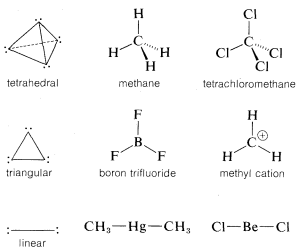


 علم الكيمياء
علم الكيمياء 
 الكيمياء التحليلية
الكيمياء التحليلية 
 الكيمياء الحياتية
الكيمياء الحياتية 
 الكيمياء العضوية
الكيمياء العضوية 
 الكيمياء الفيزيائية
الكيمياء الفيزيائية
 الكيمياء اللاعضوية
الكيمياء اللاعضوية 
 مواضيع اخرى في الكيمياء
مواضيع اخرى في الكيمياء
 الكيمياء الصناعية
الكيمياء الصناعية |
أقرأ أيضاً
التاريخ: 6-10-2020
التاريخ: 23-12-2021
التاريخ: 27-10-2019
التاريخ: 10-3-2016
|
Molecules of the type AX4, which have four identical ligands on the central atom and no unshared electrons on A (e.g., CH4 and CCl4), are expected to be, and are, tetrahedral. By the same reasoning, three electron pairs around one atom should seek a planar arrangement with 120o angles to minimize electron repulsion; accordingly, species of the type AX3, which have no unshared pairs on A (e.g., BF3 and CH3⊕), have this geometry. With only two electron pairs, the preferred arrangement is linear.

The bond angles of compounds with multiple bonds can be explained similarly. For example, in ethene the four electrons of the double bond occupy the region in space between the two carbon nuclei. The situation at either carbon is rather like the AX3 case, except that one of the ligands now has a double complement of bonding electrons:

Therefore the carbon orbitals are expected to be directed in one plane to give bond angles that deviate somewhat from 120o because of the high density of electrons in the multiple bond. Thus the H−C−H angle shrinks to 117o, whereas the H−C=C angles open up to 122o, because repulsion between electrons in the H−C=C bonds is greater than between electrons in the H−C−H bonds.
Electron-attracting power (or electronegativity) of the ligands also is important in determining bond angles. Thus for compounds of the type CH3X, in which X is a more electron-attracting group than carbon, the C−X bond is polarized in the sense H3Cδ⊕−−−Xδ⊖, and the carbon then should have some of the character of CH3⊕. Thus the H−C−H angles are expected to be greater than 109.5o, as in fact they are. In chloromethane, for example, the H−C−H angle is 111o.
Also, we can explain on the basis of electron repulsions why the bond angle in phosphine, :PH3 (93o), is less than that in ammonia, :NH3 (107.3o), and the bond angle in H:S¨⋅⋅:H (92.2o) is less than that in H:O¨⋅⋅ (104.5o). The important point is that phosphorus and sulfur are larger atoms than nitrogen and oxygen. This means than the H−S−H and H−P−H bond angles can be about 90o without bringing the hydrogens and the bonding pairs as close together as they are in H2O and NH3 where the bond angles are near to the tetrahedral value.



|
|
|
|
التوتر والسرطان.. علماء يحذرون من "صلة خطيرة"
|
|
|
|
|
|
|
مرآة السيارة: مدى دقة عكسها للصورة الصحيحة
|
|
|
|
|
|
|
نحو شراكة وطنية متكاملة.. الأمين العام للعتبة الحسينية يبحث مع وكيل وزارة الخارجية آفاق التعاون المؤسسي
|
|
|